Monday, September 4
****
Yusuf Khel and Yahya Khel, Paktika Province, 1 AM: Taliban guerrillas attacked these two towns, killing 2 policemen and wounding 3 more in the separate attacks. The two towns are located near one another. Yusuf Khel (map here) is in Sarobi District, 7 miles southwest of the capital of Sarobi.
Yahya Khel (map here) is in the Gomal District, 7 1/2 miles north of the capital of Gomal. Although the article says they are near the Pakistani border, actually the towns are near the center of Paktika Province.
*****
****
Garmser, Garmser District, Helmand Province, Early: Guerrillas attacked a police headquarters in Garmser, the capital of Garmser District. 16 Taliban and 3 police were killed. Garmser is located in the Margo Desert, or the Desert of Death.
Most of the towns here are located along the Helmand River, where the principal crop is opium. This is a very fundamentalist region that is basically controlled by the Taliban and drug traffickers. The Margo Desert is a formless rock desert with few landmarks and little or nothing grows there, except along the river.
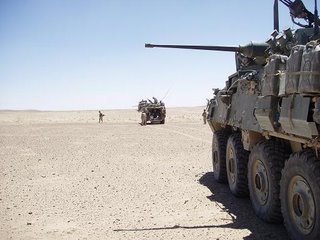 A photo of the Margo ("Death") Desert in Helmand Province. The Margo extends across southern Helmand and Nimruz Provinces, following the Helmand River. The river ends in a series of marshes just inside Iran called the Hamun or Sistan Salt Marshes. This interesting marshy area in the middle of a searing desert is rapidly deteriorating due to water diversions.
A photo of the Margo ("Death") Desert in Helmand Province. The Margo extends across southern Helmand and Nimruz Provinces, following the Helmand River. The river ends in a series of marshes just inside Iran called the Hamun or Sistan Salt Marshes. This interesting marshy area in the middle of a searing desert is rapidly deteriorating due to water diversions.The Margo is a formless desert with few landmarks, yet the locals somehow never get lost there and find their way around quite well. Garmser is located in the Margo Desert.
 Kuchi nomads camping in the Margo Desert. There are actually some plants growing in parts of this desert, but it is mostly one type of very hardy plant. The Kuchis, who dress in colorful outfits, wander around parts of Afghanistan with their herds looking for areas to seasonally graze their flocks.
Kuchi nomads camping in the Margo Desert. There are actually some plants growing in parts of this desert, but it is mostly one type of very hardy plant. The Kuchis, who dress in colorful outfits, wander around parts of Afghanistan with their herds looking for areas to seasonally graze their flocks.They are similar in some respects to the Gypsies but differ in many other ways. They are Muslims and have a deep tribal code about taking in outsiders. One story said that Ayman Zawahiri, the #2 Al Qaeda leader, was seen traveling with a group of Kuchis in Paktia and Khost Provinces in 2002.
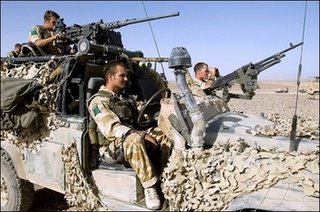 British troops in the Registan Desert in Helmand Province. Most of the Registan is in southern Kandahar Province, but part of it extends into Helmand near Garmser.
British troops in the Registan Desert in Helmand Province. Most of the Registan is in southern Kandahar Province, but part of it extends into Helmand near Garmser.*****
*****
Pashmul, Panjwayi District, Kandahar Province: Coalition forces reported that 200 Taliban had been killed so far in Operation Medusa, that began on Saturday. The operation is apparently centered around the Panjwayi District in Kandahar. Afghan forces reported 89 Taliban were killed, 80 more surrendered and a further 180 fled.
What is interesting is that a while back US and Afghan authorities felt that there were only 200 Taliban in all of Panjwayi Province. Those 200 Taliban have now been killed more than once. I think their original estimate was too low. Coalition forces decided to launch the operation because more Taliban were moving into the area.
These Taliban are reportedly more seasoned fighters than the previous fighters in the area. They have been moving ammunition into the area, sandbagging buildings and hardening their positions.
1 Canadian soldier was killed and 5 more were wounded by friendly fire when their position was strafed by a NATO jet. Orchards where Taliban fighters were reportedly hiding were bombed. There were differing reports on whether there were civilian casualties or not. Pashmul could not be located on any map.
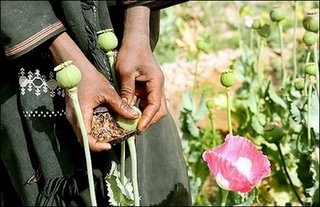 Opium in the Panjwayi District. There is a fairly large opium crop grown in this district but it is not nearly as large as the crop grown in Helmand Province next door.
Opium in the Panjwayi District. There is a fairly large opium crop grown in this district but it is not nearly as large as the crop grown in Helmand Province next door.*****
Kabul: Suicide car bomb attack on British convoy on the Kabul-Jalalabad Road killed 1 British soldier and seriously wounded 1 more. 2 other Coalition troops were killed. 2 Afghans were killed and 7 more were wounded.
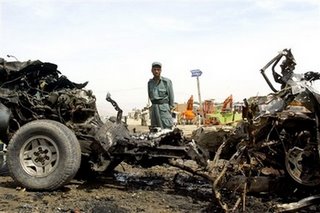 The remains of the suicide car bomb attack on British troops in Kabul that killed 1 British soldier Monday, September 4.
The remains of the suicide car bomb attack on British troops in Kabul that killed 1 British soldier Monday, September 4.*****
Parwan Province: Guerrillas killed 2 policemen here. Policemen and senior officials have been killed here every day for the past three days. This area north or Kabul has never been hostile and it is hard to understand what is going on here.
Sunday, August 3
*****
Panjwayi District, Kandahar Province: Operation Medusa, an effort to drive the Taliban from the District, continued for the second day. 4 Canadian soldiers were killed and 7 more were wounded in very heavy fighting here. Warrant Officer Richard Francis Nolan, Warrant Officer Frank Robert Mellish and 2 other soldiers were killed in the fighting. There are further details available.
*****
Kabul Airport, 12:30 PM: Mortar attack on the Kabul Airport. The Bulgarians just took charge of the airport at the end of July. There were no casualties in the attack.
Saturday, August 2
*****
Panjwayi District, Kandahar Province, 4 PM: A British RAF Nimrod MR2 reconnaissance plane supporting Operation Medusa crashed here, 12 miles west of Kandahar, near Kharot, in an operation intended to drive the Taliban out of this district, killing 14 British servicemen on board, in the worst loss of life for the Coalition in the South.
NATO said that the plane crashed due to mechanical difficulties, but the Taliban claimed to have shot it down with a Stinger missile. The Taliban are known to lie and take credit for downing aircraft that go down due to mechanical failure.
The following RAF personnel were killed in the crash: Flt Lt. Steven Johnson, Flt Lt. Leigh Anthony Mitchelmore, Flt. Lt. Gareth Rodney Nicholas, Flt. Lt. Allan James Squires, Flt. Lt. Steven Swarbrick, Flight Sgt. Gary Wayne Andrews, Flight Sgt Stephen Beattie, Flight Sgt. Gerard Martin Bell and Flight Sgt Adrian Davies, Sgt Benjamin James Knight, Sgt John Joseph Langton and Sgt Gary Paul Quilliam.
In addition, a British soldier, Lance Corporal Oliver Simon Dicketts, and a British Royal Marine, Joseph David Windall, were also killed.
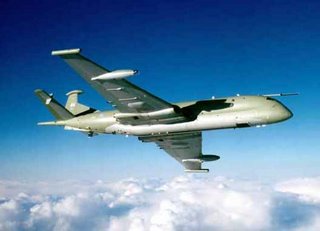 A photo of the impressive RAF Nimrod MR2 Reconnaissance plane from the British Ministry of Defense web page. This is the plane that went down on Saturday, August 2, killing all 14 British servicemen on board in one of the worst single incidents of the war for the Coalition.
A photo of the impressive RAF Nimrod MR2 Reconnaissance plane from the British Ministry of Defense web page. This is the plane that went down on Saturday, August 2, killing all 14 British servicemen on board in one of the worst single incidents of the war for the Coalition.****
Bati Kot District, Nangarhar Province: Suicide car bomb attack on a US convoy here damaged a US vehicle but did not cause any US casualties. In addition to the bomber, 1 Afghan was killed and 2 more were wounded in the attack. The Bati Kot District is 23 miles southeast of Jalalabad, the capital of Nangarhar.
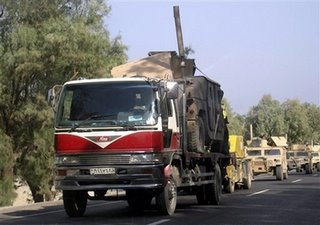 A damaged US military vehicle being towed after a suicide car bomb attack in the Bari Kot District of Nangarhar Province on Saturday, August 2. Note that this part of Afghanistan is wetter and has more trees than the much drier areas to the south.
A damaged US military vehicle being towed after a suicide car bomb attack in the Bari Kot District of Nangarhar Province on Saturday, August 2. Note that this part of Afghanistan is wetter and has more trees than the much drier areas to the south.*****
Friday, September 1
Ghazni Province, AM: A district governor, Habibullah Khan, and his entourage of 6 bodyguards, was ambushed by the Taliban as they were on their way to the capital city of Ghazni. Khan was killed in the attack but there were differing reports on whether or not his bodyguards were killed or wounded. The Taliban said they killed all of the bodyguards but the government said that they were only wounded.
Helmand Province, 4 PM: The Taliban attacked British forces here, killing 1 British soldier, Army Ranger Anare Draiva, and seriously wounding 1 more. There were no further details on the attack, including where in Helmand it occurred. Draiva was a Fijian.
Thursday, August 31
*****
Ghazni Province: A Dutch F-16 flying at a very high altitude went down, killing the pilot. The plane apparently went down due to mechanical problems, as it was flying too high to be shot down.
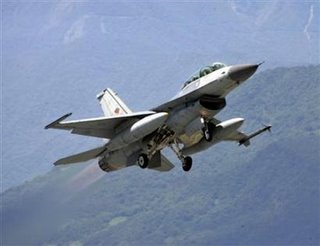 Photo of an F-16 in action. A Dutch F-16 went down due to mechanical problems over Ghazni Province on Thursday, August 31, killing the pilot.
Photo of an F-16 in action. A Dutch F-16 went down due to mechanical problems over Ghazni Province on Thursday, August 31, killing the pilot.*****
Helmand Province: More "foreign fighters" are reportedly present in the Taliban fighters that the British are fighting in red-hot Helmand Province, according to an article in the Gulf Times. Previously, most of the fighters were local Afghans from the South of the country. The article did not state what country the fighters were coming from, but there was a suggestion that they were Pakistanis.
*****
Kabul: The Afghan government is considering reinstating the morality police of the Taliban, but they will not have whips. Instead, they will supposedly gently counsel Afghans to please engage in proper Muslim behavior. The problem is the disconnect between the Westernized society of Kabul and the very conservative remainder of Afghanistan. Beer is sold openly in Kabul, even to local Afghans.
There are number of brothels with Chinese and East European women. They mostly cater to Westerners, but they also have some Afghan clients. Cinemas showing risque movies from India with women in bikinis, tame by Western standards, are filled with Afghan men recording scenes on their cell phones. Many women are walking around without a headscarf, much less a burka.
All of this hedonism is producing a backlash in favor of the morality police and new laws. As is typical in Islamic societies, curiously, the very people indulging in the vices are amongst those calling for the crackdown. Among the new laws being considered are laws forbidding the sale of alcohol and censoring sexy movies.
*****
Wednesday, August 30
Mehman Qala, Andar District, Ghazni Province: The Taliban raided a police checkpoint here in this Taliban-controlled province and opened fire on the police. The police returned fire, killing 2 Taliban and wounding 3 more. Ghazni has been getting increasingly unstable in recent months. Mehman Qala is about 3 miles north of the capital city of Miri.
Tuesday, August 29
Nuristan Province: Police found the body of Mohammad Yunus, a former commander in Gulbuddin Hekmatyar's Hezb-i-Islami during the war against the Soviet Union. Yunus had recently established a militia to support Karzai's government. He was captured with his two bodyguards in Nuristan by unknown persons who were probably insurgents on August 20.
Monday, August 28
*****
An obscure Islamist group, the Council of the Secret Army (CSA), announced that it was joining forces with Gulbuddin Hekmatyar's Hezb-i-Islami. In 2004, Hekmatyar announced that he was recruiting fighters under the banner of the Secret Army of the Mujahedin to fight the foreign forces in Afghanistan. That same organization threatened to kill candidates in the Afghan elections in 2005.
In July of this year, a group called the Secret Army of the Taliban claimed responsibility for an explosion at a Bangladeshi NGO in northern Afghanistan. Some feel that the CSA are neo-Taliban, but if so, why did they not sign on with the Taliban instead of Hekmatyar? Hekmatyar, while a radical Islamist, is generally considered to be not as extreme as the Taliban.
He is mostly concerned with throwing the foreign forces out of Afghanistan. His origins are in the Afghan Muslim Brotherhood back in the 1960's. His base is mostly in the east around Nangarhar, Kunar and Nuristan.
Hekmatyar was one of the worst warlords in the intertribal fighting that followed the defeat of the pro-Soviet regime. He played a large role in the destruction of Kabul in mid-1990's with indiscriminate shelling of the city.
*****
****
Qarya-i-Qol, Qarabagh District, Ghazni Province: 2 Afghan soldiers were captured by the Taliban in this increasingly unstable district. They were taken somewhere and then the Taliban used one of the soldiers' cell phones to call his base. As another soldier listened, the Taliban tortured to death the 2 soldiers.
This is really creepy, like something out of a horror movie. The article states that the crime occurred in a place called the Crirgia Gala Valley. This is probably a reference to the town of Qarya-i-Qol (map here) and a valley nearby.
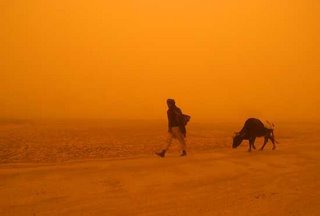 A man and an animal walk during a sandstorm in Ghazni Province in an undated picture. This creepy photograph goes nicely with the creepy war crime story above that took place in Ghazni Province.
A man and an animal walk during a sandstorm in Ghazni Province in an undated picture. This creepy photograph goes nicely with the creepy war crime story above that took place in Ghazni Province.
No comments:
Post a Comment